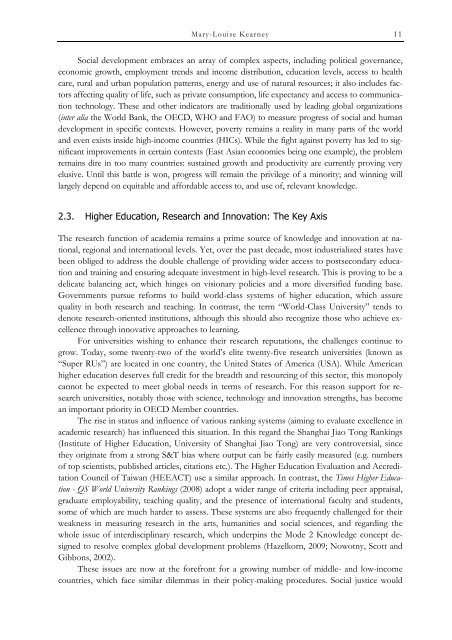Higher education, research and innovation ... - unesdoc - Unesco
Higher education, research and innovation ... - unesdoc - Unesco
Higher education, research and innovation ... - unesdoc - Unesco
You also want an ePaper? Increase the reach of your titles
YUMPU automatically turns print PDFs into web optimized ePapers that Google loves.
Mary-Louise Kearney 11<br />
Social development embraces an array of complex aspects, including political governance,<br />
economic growth, employment trends <strong>and</strong> income distribution, <strong>education</strong> levels, access to health<br />
care, rural <strong>and</strong> urban population patterns, energy <strong>and</strong> use of natural resources; it also includes factors<br />
affecting quality of life, such as private consumption, life expectancy <strong>and</strong> access to communication<br />
technology. These <strong>and</strong> other indicators are traditionally used by leading global organizations<br />
(inter alia the World Bank, the OECD, WHO <strong>and</strong> FAO) to measure progress of social <strong>and</strong> human<br />
development in specific contexts. However, poverty remains a reality in many parts of the world<br />
<strong>and</strong> even exists inside high-income countries (HICs). While the fight against poverty has led to significant<br />
improvements in certain contexts (East Asian economies being one example), the problem<br />
remains dire in too many countries: sustained growth <strong>and</strong> productivity are currently proving very<br />
elusive. Until this battle is won, progress will remain the privilege of a minority; <strong>and</strong> winning will<br />
largely depend on equitable <strong>and</strong> affordable access to, <strong>and</strong> use of, relevant knowledge.<br />
2.3. <strong>Higher</strong> Education, Research <strong>and</strong> Innovation: The Key Axis<br />
The <strong>research</strong> function of academia remains a prime source of knowledge <strong>and</strong> <strong>innovation</strong> at national,<br />
regional <strong>and</strong> international levels. Yet, over the past decade, most industrialized states have<br />
been obliged to address the double challenge of providing wider access to postsecondary <strong>education</strong><br />
<strong>and</strong> training <strong>and</strong> ensuring adequate investment in high-level <strong>research</strong>. This is proving to be a<br />
delicate balancing act, which hinges on visionary policies <strong>and</strong> a more diversified funding base.<br />
Governments pursue reforms to build world-class systems of higher <strong>education</strong>, which assure<br />
quality in both <strong>research</strong> <strong>and</strong> teaching. In contrast, the term “World-Class University” tends to<br />
denote <strong>research</strong>-oriented institutions, although this should also recognize those who achieve excellence<br />
through innovative approaches to learning.<br />
For universities wishing to enhance their <strong>research</strong> reputations, the challenges continue to<br />
grow. Today, some twenty-two of the world’s elite twenty-five <strong>research</strong> universities (known as<br />
“Super RUs”) are located in one country, the United States of America (USA). While American<br />
higher <strong>education</strong> deserves full credit for the breadth <strong>and</strong> resourcing of this sector, this monopoly<br />
cannot be expected to meet global needs in terms of <strong>research</strong>. For this reason support for <strong>research</strong><br />
universities, notably those with science, technology <strong>and</strong> <strong>innovation</strong> strengths, has become<br />
an important priority in OECD Member countries.<br />
The rise in status <strong>and</strong> influence of various ranking systems (aiming to evaluate excellence in<br />
academic <strong>research</strong>) has influenced this situation. In this regard the Shanghai Jiao Tong Rankings<br />
(Institute of <strong>Higher</strong> Education, University of Shanghai Jiao Tong) are very controversial, since<br />
they originate from a strong S&T bias where output can be fairly easily measured (e.g. numbers<br />
of top scientists, published articles, citations etc.). The <strong>Higher</strong> Education Evaluation <strong>and</strong> Accreditation<br />
Council of Taiwan (HEEACT) use a similar approach. In contrast, the Times <strong>Higher</strong> Education<br />
- QS World University Rankings (2008) adopt a wider range of criteria including peer appraisal,<br />
graduate employability, teaching quality, <strong>and</strong> the presence of international faculty <strong>and</strong> students,<br />
some of which are much harder to assess. These systems are also frequently challenged for their<br />
weakness in measuring <strong>research</strong> in the arts, humanities <strong>and</strong> social sciences, <strong>and</strong> regarding the<br />
whole issue of interdisciplinary <strong>research</strong>, which underpins the Mode 2 Knowledge concept designed<br />
to resolve complex global development problems (Hazelkorn, 2009; Nowotny, Scott <strong>and</strong><br />
Gibbons, 2002).<br />
These issues are now at the forefront for a growing number of middle- <strong>and</strong> low-income<br />
countries, which face similar dilemmas in their policy-making procedures. Social justice would

















